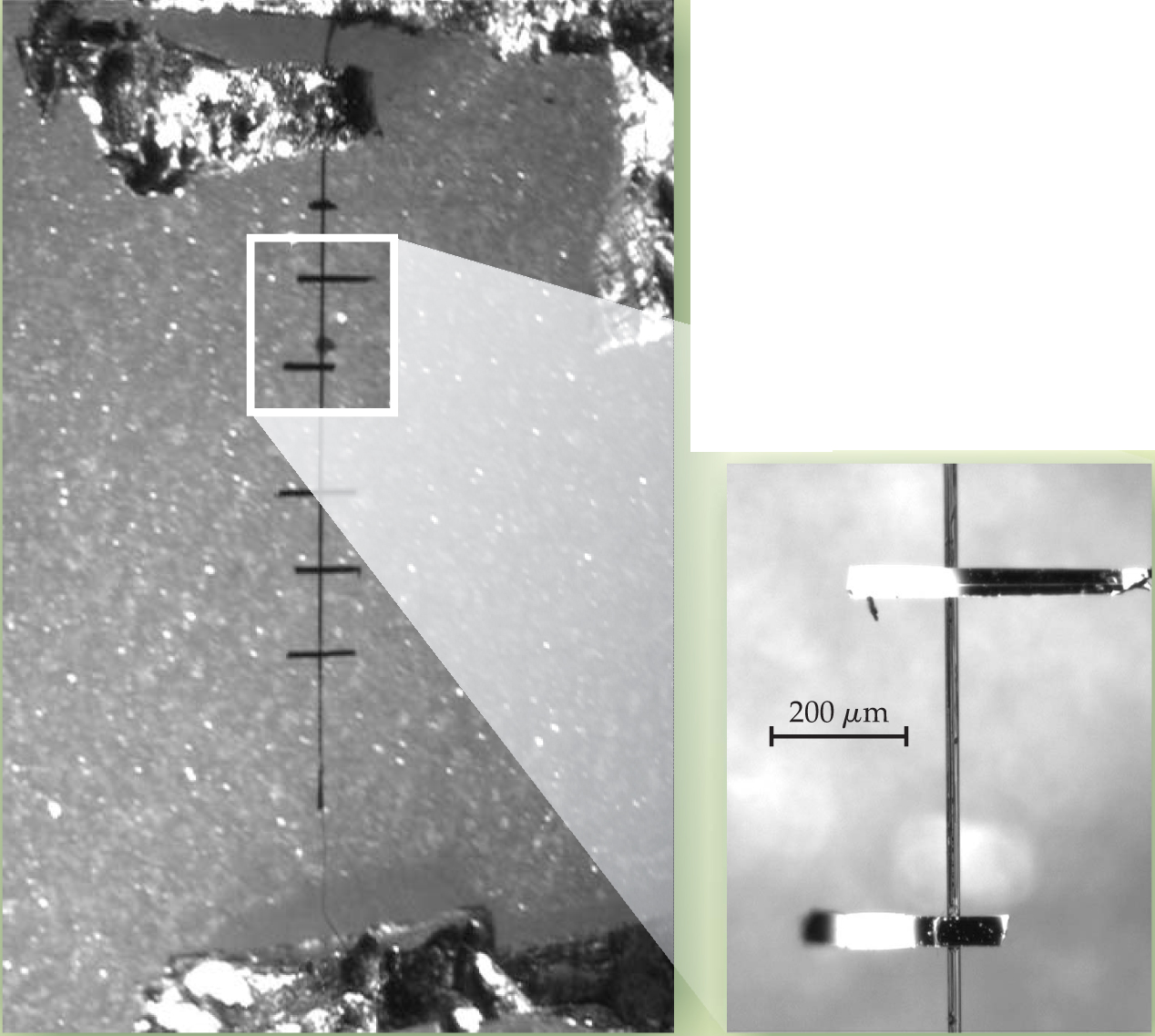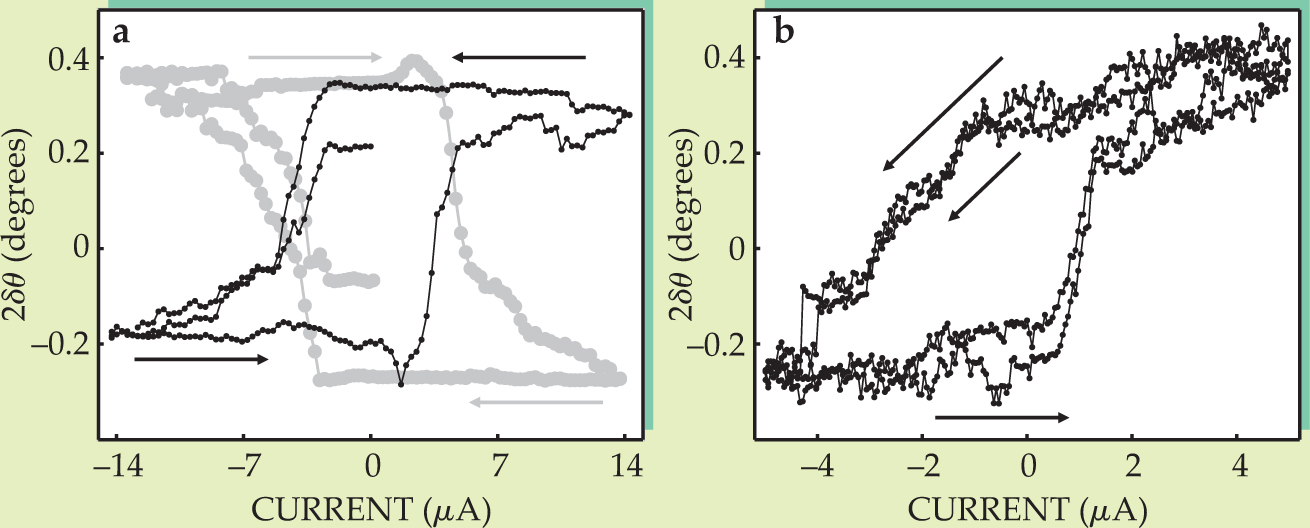Whiskers of tantalum trisulfide twist in response to an electric field
DOI: 10.1063/1.2761790
One might expect a one-dimensional metal to be rather simple: a string of equally spaced atoms whose valence electrons occupy a flat, featureless band. But in 1930 Rudolf Peierls found an interesting theoretical wrinkle.
Below a critical temperature, Peierls argued, the atoms of a 1D metal spontaneously acquire a periodic distortion that nudges them together in groups of two, three, or more. The energy cost of reordering the atoms is met by the valence electrons, which assemble in a coherent state called a charge-density wave (CDW). 1
For decades, Peierls’s idea remained untested, not least because 1D arrays of mutually attracting atoms tend to be thermodynamically unstable. But in the 1970s chemists succeeded in making bulk materials from molecular chains whose mutual coupling is strong enough to forestall thermodynamic instability yet weak enough to let the chains distort unhindered.
Physicists soon observed a host of interesting electronic properties in niobium triselenide, tantalum trisulfide, and other CDW materials. The most remarkable properties, including nonlinear conductivity, occur when an applied electric field sets the entire CDW in motion. (See the article by Robert Thorne, Physics Today, May 1996, page 42
CDW motion also changes elastic properties. In 1984 Joe Brill of the University of Kentucky and George Mozurkewich of UCLA found that TaS3, NbSe3, and (TaSe4)2I become less stiff when a CDW flows through them. And in 1992 Alex Zettl of the University of California, Berkeley, and his collaborators found that CDW motion causes centimeter-long samples of TaS3 to lengthen by a nanometer or so.
Now, Vadim Pokrovskii of the Institute of Radioengineering and Electronics in Moscow and his coworkers Sergei Zybtsev and Irina Gorlova have discovered another CDW-induced change: Freely suspended whiskers of TaS3 twist. 2
Finding one more manifestation of CDWs would not be remarkable, except for two things. First, it’s quite baffling why a whisker would choose to rotate one way rather than the other. The structure of TaS3 lacks the requisite symmetry-breaking features. Second, the twist is so large that Pokrovskii thinks his whiskers could find use as torsional actuators in micro- or nano-electromechanical systems.
Unpinning the wave
For TaS3, NbSe3, and other CDW materials, Peierls’s critical temperature T P is around 200 K. At and below T P, the reduction in electron energy that accompanies the lattice distortion opens a narrow, semiconductor-like energy gap at the Fermi surface.
If CDW materials behaved like silicon, germanium, and other semiconductors, lowering the temperature would deprive the electrons of the thermal energy they need to hop across the gap. Electrical conduction would cease. But that doesn’t happen. Thanks to the CDW’s collective nature, its constituent electrons can move en masse—provided the electric field is above a threshold value E t.
Below E t, a few scattered impurities or defects suffice to pin the CDW to the lattice. Above E t, a microscopic movie of the lattice—if one could be made—would show the electrons and atoms rocking back and forth like fluid elements in a wave while the electric field drives the crests of charge over the impurities and defects. That coordinated motion is what changes a CDW material’s properties.
CDW materials derive their distinctive character from a 1D transition; yet they are fully 3D. Out of that mix of dimensions, Pokrovskii hopes to find interesting and novel properties using atomic force microscopy, scanning tunneling microscopy, and other techniques in the nanotech toolbox.
Setting up such experiments is time-consuming. Impatient to get started, Zybtsev decided to look for one kind of deformation—torsion—in a simpler, lower-tech way.
Of the CDW materials synthesized so far, orthorhombic TaS3 shows the biggest CDW-induced change in stiffness. It’s typically available in the form of thin whiskers. Zybtsev attached tiny mirrors to TaS3 whiskers and suspended them vertically between two contacts (see figure 1). He then aimed a laser beam at the mirrors and positioned a detector to intercept the reflected beam. If the whiskers twisted, the beam would be deflected, and the detector would measure the deflection angle.

Figure 1. When a charge-density wave flows along a whisker of tantalum trisulfide, the whisker twists. To measure the twist angle, a team from Russia’s Institute of Radioengineering and Electronics aimed a laser beam at tiny superconducting mirrors attached to the whisker.
(Adapted from ref. 2.)

As the voltage along the whiskers approached the threshold for depinning the CDW, the whiskers began to twist, the angle increasing rapidly until it saturated at about 0.2 degrees. As figure 2 shows, reducing the voltage back to zero and then reversing it led to a hysteresis and a reversal of the twist direction.

Figure 2. At the start of the experiment, the current and deflection are both zero. Once the threshold for charge-density wave motion is reached—a current of about 4 µA for sample (a) and 1 µA for sample (b)—the deflection rapidly climbs, then saturates. Reversing the current reveals considerable hysteresis. Turning sample (a) upside down (gray image) reverses the direction of the twist.
(Adapted from ref. 2.)

The hysteresis is not unexpected and reflects the presence of domains. But the value of the deflection was surprisingly large. It corresponds to a surface strain of 10−4 and a piezoelectric coefficient of 10−4 cm/V, which is four orders of magnitude larger than that of PZT, a piezoelectric material used for high-precision alignment systems and scanning stages.
To convince themselves they’d seen a real, CDW-induced effect, Pokrovskii, Zybtsev, and Gorlova ran several tests. All 13 of their samples, whose cross-sectional areas ranged from 5 to 300 µm2, showed the effect. They also attached a series of mirrors along the length of whiskers. As expected for an intrinsic material property, the deflection increased linearly along the sample length. The deflection was also larger overall at lower temperatures.
Although Pokrovskii, Zybtsev, and Gorlova haven’t identified the twist’s origin, their experiments limit the possibilities. The shadow image in figure
Both tests point to an intrinsic, structural origin for the twist, yet the structure of orthorhombic TaS3, whose unit cell consists of 24 tantalum sulfide chains, has neither up–down nor left–right asymmetry. Because torsional strain deforms the surface of a whisker more than its interior, defects or impurities at the surface could be responsible. Angle-resolved photoemission studies could help reveal whether that’s the case.
Even if the twist remains mysterious, it appears to be robust and repeatable. TaS3 whiskers could serve as torsional actuators. All that’s needed to generate twist is an electrical field and one moving part. No other actuator, microscopic or macroscopic, would be as simple.
References
1. R. E. Peierls, Ann. Phys. (Leipzig) 4, 121 (1930).
2. V. Y. Pokrovskii, S. G. Zybtsev, I. G. Gorlova, Phys. Rev. Lett. 98, 206404 (2007). https://doi.org/10.1103/PhysRevLett.98.206404
